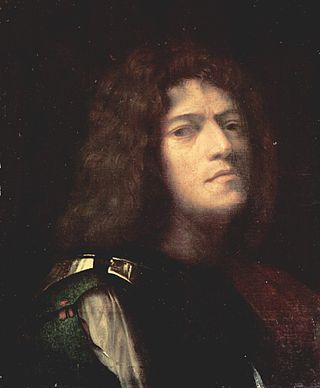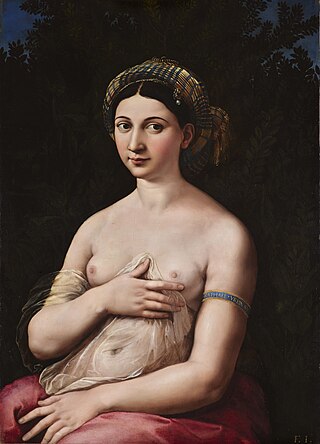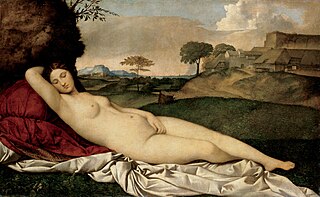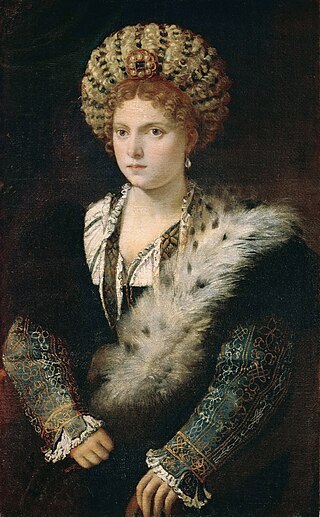
Giorgio Barbarelli da Castelfranco, known as Giorgione, was an Italian painter of the Venetian school during the High Renaissance, who died in his thirties. He is known for the elusive poetic quality of his work, though only about six surviving paintings are firmly attributed to him. The uncertainty surrounding the identity and meaning of his work has made Giorgione one of the most mysterious figures in European art.

Olympia is a 1863 oil painting by Édouard Manet, depicting a nude white woman ("Olympia") lying on a bed being attended to by a black maid. The French government acquired the painting in 1890 after a public subscription organized by Claude Monet. The painting is now in the Musée d'Orsay, Paris.

The Rokeby Venus is a painting by Diego Velázquez, the leading artist of the Spanish Golden Age. Completed between 1647 and 1651, and probably painted during the artist's visit to Italy, the work depicts the goddess Venus in a sensual pose, lying on a bed with her back facing the viewer, and looking into a mirror held by the Roman god of physical love, her son Cupid. The painting is in the National Gallery, London.

The Venus of Urbino is an oil painting by Italian painter Titian, depicting a nude young woman, traditionally identified with the goddess Venus, reclining on a couch or bed in the sumptuous surroundings of a Renaissance palace. Work on the painting seems to have begun anywhere from 1532 or 1534, and was perhaps completed in 1534, but not sold until 1538. It is currently held in the Galleria degli Uffizi in Florence.

The Portrait of a Young Woman is a painting by the Italian High Renaissance master Raphael, made between 1518 and 1519. It is in the Galleria Nazionale d'Arte Antica in Palazzo Barberini, Rome.

The Self-Portrait with a Friend is a painting by Italian High Renaissance painter Raphael. It dates to 1518–1520, and is in the Louvre Museum of Paris, France. Whether the figure on the left is actually a self-portrait by Raphael is uncertain, although it was already identified as such in a 16th-century print.

The Sleeping Venus, also known as the Dresden Venus, is a painting traditionally attributed to the Italian Renaissance painter Giorgione, although it has long been widely thought that Titian completed it after Giorgione's death in 1510. The landscape and sky are generally accepted to be mainly by Titian. In the 21st century, much scholarly opinion has shifted further, to see the nude figure of Venus as also painted by Titian, leaving Giorgione's contribution uncertain. It is in the Gemäldegalerie, Dresden. After World War II, the painting was briefly in possession of the Soviet Union.

The Venetian painter Titian and his workshop made at least six versions of the same composition showing Danaë, painted between about 1544 and the 1560s. The scene is based on the mythological princess Danaë, as – very briefly – recounted by the Roman poet Ovid, and at greater length by Boccaccio. She was isolated in a bronze tower following a prophecy that her firstborn would eventually kill her father. Although aware of the consequences, Danaë was seduced and became pregnant by Zeus, who, inflamed by lust, descended from Mount Olympus to seduce her in the form of a shower of gold.

Portrait of Isabella d'Este is an oil on canvas painting of a young woman by Titian. It can be dated to the 1530s and is held in the Kunsthistorisches Museum, in Vienna. The artist and the date are undisputed. Beyond the museum documentation, there are several doubts about the person depicted.

Lucretia and her Husband Lucius Tarquinius Collatinus or Tarquin and Lucretia is an oil painting attributed to Titian, dated to around 1515 and now in the Kunsthistorisches Museum in Vienna. The attribution to this artist is traditional but uncertain - the brightened palette suggests it could instead be by Palma Vecchio. However, others identify the painting as part of Titian's series of half-length female figures from 1514 to 1515, which also includes the Flora at the Uffizi, the Woman with a Mirror at the Louvre, the Violante and the Young woman in a black dress in Vienna, Vanity in Munich and the Salome at the Galleria Doria Pamphilj. There is an early copy in the Royal Collection.

Tarquin and Lucretia is an oil painting by Titian completed in 1571, when the artist was in his eighties, for Philip II of Spain. It is signed, and considered to have been finished entirely by Titian himself. It is one of a series of great works from Titian's last years, but unlike some of these, is fully finished. It is now in the Fitzwilliam Museum in Cambridge, England.

The Penitent Magdalene is a painting of saint Mary Magdalene by Titian dating to around 1531, signed 'TITIANUS' on the ointment jar to the left. It is now in the Sala di Apollo of the Palazzo Pitti in Florence, Italy.

The Tribute Money is a panel painting in oils of 1516 by the Italian late Renaissance artist Titian, now in the Gemäldegalerie Alte Meister in Dresden, Germany. It depicts Christ and a Pharisee at the moment in the Gospels when Christ is shown a coin and says "Render unto Caesar the things that are Caesar's, and unto God the things that are God's". It is signed "Ticianus F.[ecit]", painted on the trim of the left side of the Pharisee's collar.

Portrait of Laura Dianti is a c. 1520–25 painting by Titian, now held in the H. Kisters Collection at Kreuzlingen. It is signed "TICI/ANVS F." The portrait features Laura Dianti, mistress, and later wife of the Duke of Ferrara Alfonso I d'Este and an African page. She is dressed in a blue dress with her hand placed on the shoulder of her page as he looks up at her. The painting is possibly associated with a portrait of Alfonso I d'Este. It is also controversial in that it was used to contest the legitimacy of the pair's marriage after the duke's death. It traveled through many locations and was initially thought to be one of many copies until a restoration uncovered a signature by Titian.

La Bella is a portrait of a woman by Titian in the Palazzo Pitti in Florence. The painting shows the subject with the ideal proportions for Renaissance women. In parallel the stringent composition corresponds to Titian's real portraits. The work can be dated by a letter about "that portrait of that woman in a blue dress" in May 1536.

The Blue Room is a 1923 painting by French artist Suzanne Valadon. One of her most recognizable works, it has been called a radical subversion of representation of women in art. Like many of Valadon's later works, it uses strong colors and emphasizes decorative backgrounds and patterned materials. Valadon depicts a modern 20th-century woman, clothed and smoking a cigarette, in a pose traditional to female nudes, particularly 19th-century images of odalisques and prostitutes, such as Edouard Manet's Olympia.

The Fur or The Pelt, also called The Little Fur, or Helena Fourment in a Fur Robe, is a c. 1636–1638 portrait by Peter Paul Rubens of his second wife Helena Fourment getting out of her bath and wrapping her voluptuous body in a fur. It is now in the Kunsthistorisches Museum in Vienna.

La Dormeuse de Naples was an 1809 painting by the French artist Jean-Auguste-Dominique Ingres, now lost. He reused the pose in two later works, Odalisque with Slave (1839) and Jupiter and Antiope (1851).

The Pardo Venus is a painting by the Venetian artist Titian, completed in 1551 and now in the Louvre Museum. It is also known as Jupiter and Antiope, since it seems to show the story of Jupiter and Antiope from Book VI of the Metamorphoses. It is Titian's largest mythological painting, and was the first major mythological painting produced by the artist for Philip II of Spain. It was long kept in the Royal Palace of El Pardo near Madrid, hence its usual name; whether Venus is actually represented is uncertain. It later belonged to the English and French royal collections.

Portrait of Eleonora Gonzaga della Rovere is a 1538 painting by Titian, now in the Uffizi in Florence alongside its pair, Portrait of Francesco Maria della Rovere, showing Eleonora's husband. It formed the prototype for some of his later portraits, such as that of Isabella of Portugal.




















